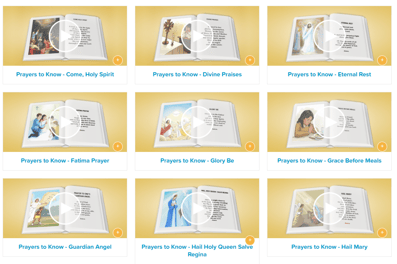The Christian life is ordered toward union with God. Prayer is the means by which we lift our minds and hearts to the God who loves us. Word of Life incorporates several methods of prayer. It introduces lectio divina to children so that at a young age they can begin to have a personal experience of reading, meditating on, praying with, and listening to Scripture. It teaches children how to engage with sacred art and beauty through prayer. It also gives ample opportunities for students and families to learn the practice of mental prayer and reflection.
Lectio Divina in Word of Life
Lectio divina is an ancient form of praying with Scripture. The name is Latin for “divine reading.” The steps of lectio divina used today were developed by a Carthusian monk in the twelfth century.
- With each grade of the Word of Life series, students will grow in their ability to pray using lectio divina. Our goal is to give the students a short and simple experience of reading and praying with Scripture.
- Lectio divina will help the students practice silence.
- Reflecting on the Scripture passage will prepare the students for the lesson.
- Because the lectio verses are quoted directly from the Bible, students will hear the Word of God.
Lectio Divina - Quick Start Guide
At the beginning of the year, you may want to lead students verbally, with the intention that they learn to reflect silently. Verbal prompts are in bold italics below.
There are four rungs on the ladder of lectio divina. Each rung has a traditional Latin name, but the English translation is also given below.
Begin and end with the Sign of the Cross.
In the name of the Father . . .
Dear God, I want to hear You speak to me through Your Word in the Bible. Help me hear Your Word with my ears and with my heart.
1. Lectio (Reading). The teacher (or student) reads the words from Scripture (see lesson). The students should simply listen to the words. God speaks first through His Word and we are listening to Him. If students seem to be confused by the meaning of the Scripture passage, you may help them out, but remind them that it is God who is speaking to them.
Read Scripture verse. (Pause.)
Read Scripture verse again. (Pause.)
2. Meditatio (Meditation). This step should merely encourage students to meditate or think about what they just heard.
Did any words, pictures, or thoughts come into your heart? (Pause.)
Optional: Listen to this reflection. (Read lectio reflection from lesson.)
Did any words, pictures, or thoughts come into your heart? (Pause.)
Do you think that God is saying something to you? (Pause.)
Does God’s Word help you know His love? (Pause.) His comfort? (Pause.) His strength? (Pause.)
Optional: Does God’s Word help you know His (other)? (Pause.)
3. Oratio (Prayer). Here, students respond to the Word of God. They respond either through quiet mental prayer, by writing in a journal, or, for young children, by drawing a picture, possibly in a prayer journal.
Now we will silently respond to God in prayer. You may quietly offer praise (tell God how much you love Him and why) or give thanks to God; you may want to ask God for His help.
Is there something you would like to say to God silently?
(Pause.)
Allow students to pray quietly, write words, or draw a picture.
4. Contemplatio (Contemplation). In this step, students should calm themselves and be in God’s presence by sitting quietly and listening to what God has to say to them. Sometimes students will simply enjoy God’s presence; other times God may speak to them in their hearts. It is God’s initiative to speak to us, not something we can make happen. As the year goes along, encourage the students to sit for longer periods of time in quiet listening. Invite students to fold their hands, close their eyes, and bow their heads in silence.
Now we will quiet ourselves as we come to know God’s presence in our hearts.
God wants to be with you and spend time with you. He may also have something to say to you in your heart.
(Pause.)
Thank You, God, for the love we find in Your Word. In the name of the Father . . .
Prayers to Know Videos
Word of Life offers 30+ prayers to know videos to help Catholic families learn the key prayers of our faith. They can be used in the classroom or assigned as homework for the children to pray with their families.

